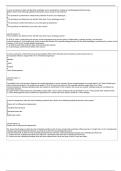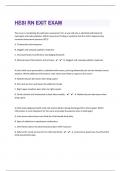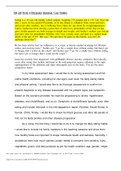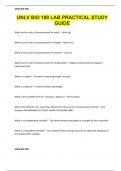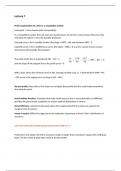Summary lectures Economics and
Management of Organizations
Content
Lecture 1: Introduction and growth of organizations ...................................................................................... 1
Management and organization ......................................................................................................................... 1
Mintzberg’s typology ......................................................................................................................................... 2
Levels of management ....................................................................................................................................... 2
Planning ............................................................................................................................................................. 3
Organizational growth in practice ..................................................................................................................... 3
Greiner’s growth model ..................................................................................................................................... 3
Lecture 2: evolution of management thought................................................................................................. 5
Scientific management theory ........................................................................................................................... 5
Administrative management theory ................................................................................................................. 6
Behaviour management theory ......................................................................................................................... 7
Management science theory .............................................................................................................................. 8
Organizational environment theory ................................................................................................................... 9
Lecture 3: organizational design and structure ............................................................................................... 9
Issue 1: job design ............................................................................................................................................ 10
Issue 2: grouping jobs into functions and divisions .......................................................................................... 11
Issue 3: how to allocate authorities and coordination ..................................................................................... 11
Lecture 4: culture ......................................................................................................................................... 12
Organizational culture ..................................................................................................................................... 12
Hofstede’s model of national culture ............................................................................................................... 13
Critical perspectives on culture ........................................................................................................................ 14
Lecture 5: leadership & motivation .............................................................................................................. 14
Leadership ........................................................................................................................................................ 14
Trends in leadership theory .............................................................................................................................. 15
Trait model .................................................................................................................................................. 15
Behavioural approach ................................................................................................................................. 16
Motivation........................................................................................................................................................ 18
Maslow’s hierarchy of needs....................................................................................................................... 19
Alderfer’s ERG theory .................................................................................................................................. 19
Herzberg’s motivator-hygiene theory ......................................................................................................... 20
McClelland’s nAch, nAff and nPower .......................................................................................................... 20
Vroom’s expectancy theory ........................................................................................................................ 20
Equity theory ............................................................................................................................................... 21
, Locke’s and Latham’s goal-setting theory ................................................................................................... 21
Lecture 6: controlling ................................................................................................................................... 21
Types of control ................................................................................................................................................ 21
Control process................................................................................................................................................. 21
Control systems ................................................................................................................................................ 22
Lecture 7: ethics and corporate social responsibility (CSR) ............................................................................ 23
Sources of ethics............................................................................................................................................... 23
Context CSR ...................................................................................................................................................... 23
CSR drivers........................................................................................................................................................ 24
Greenwashing .................................................................................................................................................. 25
Lecture 1: Introduction and growth of organizations
Management and organization
What is an organization and what are general characteristics?
- Organizations come in all sorts of shapes and sized: profit and not for profit organizations
and institutions
o Industrial companies and service companies
o Private and government-controlled firms
o Large, medium-sized and small companies
o National and multinational companies
o Charities and voluntary organizations, and so on…
- Whatever grouping we choose; all organizations have certain common features:
o People who work together and cooperate in order to reach a specific set of goals
- Definition 1 Book: collections of people who work together and coordinate their actions to
achieve a wide variety of goals or desired future
- Definition 2 Boddy: a social arrangement for achieving controlled performance towards goal
that create value
- Definition 3: value is added to resources when they are transformed into goods or services
that are worth more than their original cost plus the cost of transformation
What is management and what are their tasks?
- Definition 1 Book: management is the planning, organizing, leading and controlling of human
and other resources to achieve organizational goals efficiently and effectively
- Definition 2 Boddy: management as a universal human activity occurs whenever people take
responsibility for an activity and consciously try to shape its progress and outcome
- Definition 3: the activity of getting things done with the aid of people and other resources
- Manager = someone who gets things done with the aid of people and other resources. This
person has a supporting role in the organization.
- Management according to Jones and George:
o Planning: determining the organization’s mission, vision and goals, formulating the
strategy, identifying internal strengths and weaknesses + external opportunities and
threats (SWOT)
o Organizing grouping tasks into jobs (job design), allocating authority, incorporating
integrating mechanisms (coordination) à organizational structure
1
, o Leading: leading people, motivating, energizing and
enabling employees, using power personality, influence,
persuasion and communication skills to coordinate people
and groups (people work)
o Controlling: monitoring the performance of individuals,
departments and the organization as a whole, taking
corrective actions
Mintzberg’s typology
“Mintzberg identified 10 kinds of specific roles or sets of job responsibilities. He grouped these roles
according to the responsibility”.
1). Decisional responsibility
- Decisional responsibility: “roles associated with methods managers use in planning strategy
and utilizing resources”
- Entrepreneur: deciding which new projects or programs to initiate and to invest resources in.
Not every manager fulfils this rule, mostly top-managers
- Disturbance handler: managing an unexpected event or crises
- Resource allocator: assigning resources between functions and divisions, setting the budgets
of lower managers
- Negotiator: reaching agreements between other managers, unions, customers, or
shareholders
2). Interpersonal responsibility
- Interpersonal responsibility: “roles that managers assume to provide direction and
supervision to both employees and determining the course of the organization as a whole”
- Figurehead: symbolizing the organization’s mission and what it is seeking to achieve
(ceremonial and symbolic duties) à speeches
- Leader: training, counselling, and mentoring high employee performance
- Liaison: linking and coordinating the activities of people and groups in different departments
both inside and outside the organization
3). Informational responsibility
- Informational responsibility: “roles associated with the tasks needed to obtain and transmit
information in the process of managing the organization
- Monitor: analysing information from internal and external environment
- Disseminator: transmitting information to influence the attitudes and behaviour of
employees (primarily inside the organization)
- Spokesperson: using information to positively influence the way people outside of the
organization respond to it (primarily outside the organization).
Levels of management
1. CEO
2. Top managers: determine strategy, make the most important decisions
3. Middle managers: translate the goals of the organizational into his or her department
4. First-line managers: day to day running, first point of contact
2
Management of Organizations
Content
Lecture 1: Introduction and growth of organizations ...................................................................................... 1
Management and organization ......................................................................................................................... 1
Mintzberg’s typology ......................................................................................................................................... 2
Levels of management ....................................................................................................................................... 2
Planning ............................................................................................................................................................. 3
Organizational growth in practice ..................................................................................................................... 3
Greiner’s growth model ..................................................................................................................................... 3
Lecture 2: evolution of management thought................................................................................................. 5
Scientific management theory ........................................................................................................................... 5
Administrative management theory ................................................................................................................. 6
Behaviour management theory ......................................................................................................................... 7
Management science theory .............................................................................................................................. 8
Organizational environment theory ................................................................................................................... 9
Lecture 3: organizational design and structure ............................................................................................... 9
Issue 1: job design ............................................................................................................................................ 10
Issue 2: grouping jobs into functions and divisions .......................................................................................... 11
Issue 3: how to allocate authorities and coordination ..................................................................................... 11
Lecture 4: culture ......................................................................................................................................... 12
Organizational culture ..................................................................................................................................... 12
Hofstede’s model of national culture ............................................................................................................... 13
Critical perspectives on culture ........................................................................................................................ 14
Lecture 5: leadership & motivation .............................................................................................................. 14
Leadership ........................................................................................................................................................ 14
Trends in leadership theory .............................................................................................................................. 15
Trait model .................................................................................................................................................. 15
Behavioural approach ................................................................................................................................. 16
Motivation........................................................................................................................................................ 18
Maslow’s hierarchy of needs....................................................................................................................... 19
Alderfer’s ERG theory .................................................................................................................................. 19
Herzberg’s motivator-hygiene theory ......................................................................................................... 20
McClelland’s nAch, nAff and nPower .......................................................................................................... 20
Vroom’s expectancy theory ........................................................................................................................ 20
Equity theory ............................................................................................................................................... 21
, Locke’s and Latham’s goal-setting theory ................................................................................................... 21
Lecture 6: controlling ................................................................................................................................... 21
Types of control ................................................................................................................................................ 21
Control process................................................................................................................................................. 21
Control systems ................................................................................................................................................ 22
Lecture 7: ethics and corporate social responsibility (CSR) ............................................................................ 23
Sources of ethics............................................................................................................................................... 23
Context CSR ...................................................................................................................................................... 23
CSR drivers........................................................................................................................................................ 24
Greenwashing .................................................................................................................................................. 25
Lecture 1: Introduction and growth of organizations
Management and organization
What is an organization and what are general characteristics?
- Organizations come in all sorts of shapes and sized: profit and not for profit organizations
and institutions
o Industrial companies and service companies
o Private and government-controlled firms
o Large, medium-sized and small companies
o National and multinational companies
o Charities and voluntary organizations, and so on…
- Whatever grouping we choose; all organizations have certain common features:
o People who work together and cooperate in order to reach a specific set of goals
- Definition 1 Book: collections of people who work together and coordinate their actions to
achieve a wide variety of goals or desired future
- Definition 2 Boddy: a social arrangement for achieving controlled performance towards goal
that create value
- Definition 3: value is added to resources when they are transformed into goods or services
that are worth more than their original cost plus the cost of transformation
What is management and what are their tasks?
- Definition 1 Book: management is the planning, organizing, leading and controlling of human
and other resources to achieve organizational goals efficiently and effectively
- Definition 2 Boddy: management as a universal human activity occurs whenever people take
responsibility for an activity and consciously try to shape its progress and outcome
- Definition 3: the activity of getting things done with the aid of people and other resources
- Manager = someone who gets things done with the aid of people and other resources. This
person has a supporting role in the organization.
- Management according to Jones and George:
o Planning: determining the organization’s mission, vision and goals, formulating the
strategy, identifying internal strengths and weaknesses + external opportunities and
threats (SWOT)
o Organizing grouping tasks into jobs (job design), allocating authority, incorporating
integrating mechanisms (coordination) à organizational structure
1
, o Leading: leading people, motivating, energizing and
enabling employees, using power personality, influence,
persuasion and communication skills to coordinate people
and groups (people work)
o Controlling: monitoring the performance of individuals,
departments and the organization as a whole, taking
corrective actions
Mintzberg’s typology
“Mintzberg identified 10 kinds of specific roles or sets of job responsibilities. He grouped these roles
according to the responsibility”.
1). Decisional responsibility
- Decisional responsibility: “roles associated with methods managers use in planning strategy
and utilizing resources”
- Entrepreneur: deciding which new projects or programs to initiate and to invest resources in.
Not every manager fulfils this rule, mostly top-managers
- Disturbance handler: managing an unexpected event or crises
- Resource allocator: assigning resources between functions and divisions, setting the budgets
of lower managers
- Negotiator: reaching agreements between other managers, unions, customers, or
shareholders
2). Interpersonal responsibility
- Interpersonal responsibility: “roles that managers assume to provide direction and
supervision to both employees and determining the course of the organization as a whole”
- Figurehead: symbolizing the organization’s mission and what it is seeking to achieve
(ceremonial and symbolic duties) à speeches
- Leader: training, counselling, and mentoring high employee performance
- Liaison: linking and coordinating the activities of people and groups in different departments
both inside and outside the organization
3). Informational responsibility
- Informational responsibility: “roles associated with the tasks needed to obtain and transmit
information in the process of managing the organization
- Monitor: analysing information from internal and external environment
- Disseminator: transmitting information to influence the attitudes and behaviour of
employees (primarily inside the organization)
- Spokesperson: using information to positively influence the way people outside of the
organization respond to it (primarily outside the organization).
Levels of management
1. CEO
2. Top managers: determine strategy, make the most important decisions
3. Middle managers: translate the goals of the organizational into his or her department
4. First-line managers: day to day running, first point of contact
2


